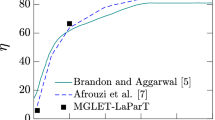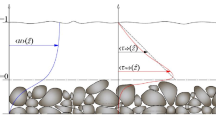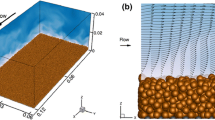Abstract
Laboratory experiments are conducted to quantify the mean flow structure and turbulence properties downstream of a spanwise suspended linear array in a uniform ambient water flow using Particle Tracking Velocimetry. Eighteen experimental scenarios, with four depth ratios (array depth to water column depth) of 0.35, 0.52, 0.78, and 0.95 and bulk Reynolds number (length scale is the array depth) from 11,600 to 68,170, are investigated. Three sub-layers form downstream of the array: (1) an internal wake zone, where the time-averaged velocity decreases with increasing distance downstream, (2) a shear layer which increases in vertical extent with increasing distance downstream of the array, and the rate of the increase is independent of the bulk Reynolds number or the depth ratio, and (3) an external wake layer with enhanced velocity under the array. The location of the shear layer is dependent on the depth ratio. The spatially averaged and normalized TKE of the wake has a short production region, followed by a decay region which is comparable to grid turbulence decay and is dependent on the depth ratio. The results suggest that the shear layer increases the transfer of horizontal momentum into the internal wake zone from the fluid outside of the array and that the turbulence in the internal wake zone can be modeled similarly to that of grid turbulence.










Similar content being viewed by others
References
Baltaxe R (1967) Air flow patterns in the lee of model windbreaks. Archiv für Meteorologie Geophysik und Bioklimatologie Ser B 15(3):287–312
Blanco J, Zapata M, Moroño Á (1996) Some aspects of the water flow through mussel rafts. Sci Mar 60:275–282
Bostock J, McAndrew B, Richards R, Jauncey K, Telfer T, Lorenzen K, Little D, Ross L, Handisyde N, Gatward I, Corner R (2010) Aquaculture: global status and trends. Philos Trans R Soc Lond B Biol Sci 365(1554):2897–2912. doi:10.1098/rstb.2010.0170
Boyd AJ, Heasman KG (1998) Shellfish mariculture in the Benguela system: water flow patterns within a mussel farm in Saldanha Bay, South Africa. J Shellfish Res 17(1):25–32
Chen Z, Jiang C, Nepf H (2013) Flow adjustment at the leading edge of a submerged aquatic canopy. Water Resour Res 49(9):5537–5551. doi:10.1002/wrcr.20403
Follett EM, Nepf HM (2012) Sediment patterns near a model patch of reedy emergent vegetation. Geomorphology 179:141–151. doi:10.1016/j.geomorph.2012.08.006
Fuentes J, Gregorio V, Giráldez R, Molares J (2000) Within-raft variability of the growth rate of mussels, Mytilus galloprovincialis, cultivated in the Ría de Arousa (NW Spain). Aquaculture 189:39–52
Ghisalberti M, Nepf H (2002) Mixing layers and coherent structures in vegetated aquatic flows. J Geophys Res. doi:10.1029/2001jc000871
Hartstein ND, Stevens CL (2005) Deposition beneath long-line mussel farms. Aquac Eng 33(3):192–213. doi:10.1016/J.Aquaeng.01.002
Hatcher A, Grant J, Schofield B (1994) Effects of suspended mussel culture (Mytilus Spp) on sedimentation, benthic respiration and sediment nutrient dynamics in a coastal bay. Mar Ecol Prog Ser 115(3):219–235. doi:10.3354/Meps115219
Heisler GM, Dewalle DR (1988) 2. Effects of windbreak structure on wind flow. Agric Ecosyst Environ 22–23:41–69
Ho CM, Huerre P (1984) Perturbed free shear layers. Annu Rev Fluid Mech 16:365–424. doi:10.1146/Annurev.Fl.16.010184.002053
Hurst D, Vassilicos JC (2007) Scalings and decay of fractal-generated turbulence. Phys Fluids. doi:10.1063/1.2676448
Infantes E, Orfila A, Simarro G, Terrados J, Luhar M, Nepf H (2012) Effect of a seagrass (Posidonia oceanica) meadow on wave propagation. Mar Ecol Prog Ser 456:63–72. doi:10.3354/meps09754
Jackson GA, Winant CD (1983) Effect of a kelp forest on coastal currents. Cont Shelf Res 2(1):75–80. doi:10.1016/0278-4343(83)90023-7
Judd MJ, Raupach MR, Finnigan JJ (1996) A wind tunnel study of turbulent flow around single and multiple windbreaks, part I—velocity fields. Bound Layer Meteorol 80:127–165
Kaimal JC, Finnigan JJ (1994) Atmospheric boundary layer flows: their structure and measurement. Oxford University Press, Oxford
Lu SS, Willmarth WW (1973) Measurement of the structure of the Reynolds stress in a turbulent boundary layer. J Fluid Mech 60(03):481–511
Lindsey WF (1938) Drag of cylinders of simple shapes, NACA Annual Report 24. National Advisory Committee for Aeronautics, Langley Aeronautical Lab. Langley Field, VA, United States, pp 169–176
Martinez GM, Campos AO, Vilar EG, Mier REL, Perez-Arlucea M (2011) Changes induced by mussel raft aquaculture in benthic environment of the Rias Baixas (Galicia, Spain). J Coast Res SI 64:786–789
Mazellier N, Vassilicos JC (2010) Turbulence without Richardson–Kolmogorov cascade. Phys Fluids 22(7):075101. doi:10.1063/1.3453708
Mohamed MS, Larue JC (1990) The decay power law in grid-generated turbulence. J Fluid Mech 219:195–214. doi:10.1017/S0022112090002919
Nepf H, Ghisalberti M (2008) Flow and transport in channels with submerged vegetation. Acta Geophys 56(3):753–777. doi:10.2478/s11600-008-0017-y
Nepf H, Ghisalberti M, White B, Murphy E (2007) Retention time and dispersion associated with submerged aquatic canopies. Water Resour Res. doi:10.1029/2006wr005362
Nepf H, Vivoni E (2000) Flow structure in depth-limited, vegetated flow. J Geophys Res 105(C12):28547. doi:10.1029/2000jc900145
Nepf HM (2012) Hydrodynamics of vegetated channels. J Hydraul Res 50(3):262–279. doi:10.1080/00221686.2012.696559
Nokes R (2014) Streams v2.03, system theory and design manual. College of Engineering University of Canterbury, Christchurch, New Zealand
Panda BB, Das BL, Lenka M, Panda KK (1988) Water hyacinth (Eichhornia crassipes) to biomonitor genotoxicity of low-levels of mercury in aquatic environment. Mutat Res 206(2):275–279. doi:10.1016/0165-1218(88)90171-1
Patton EG, Shaw RH, Judd JM, Raupach MR (1998) Large-eddy simulation of windbreak flow. Bound Layer Meteorol 87(2):275–307
Plate EJ (1971) The aerodynamics of shelter belts. Agric Meteorol 8:203–222
Plavan G, Nicoara M, Apetroaiei N, Plavan O (2012) The effects of fish cage aquaculture on the profound macrozoobenthos in the oligo-mesotrophic reservoir Izvoru Muntelui Bicaz (Romania). Carpath J Earth Environ 7(2):145–148
Plew DR (2005) The hydrodynamic effects of long-line mussel farms. University of Canterbury, Christchurch, New Zealand
Plew DR (2011) Depth-averaged drag coefficient for modeling flow through suspended canopies. J Hydraul Eng 137:234–247. doi:10.1061//ASCE/HY.1943-7900.0000300
Plew DR, Enright MP, Nokes RI, Dumas JK (2009) Effect of mussel bio-pumping on the drag on and flow around a mussel crop rope. Aquac Eng 40:55–61
Plew DR, Spigel RH, Stevens CL, Nokes RI, Davidson MJ (2006) Stratified flow interactions with a suspended canopy. Environ Fluid Mech 6(6):519–539. doi:10.1007/S10652-006-9008-1
Plew DR, Stevens CL, Spigel RH, Hartstein ND (2005) Hydrodynamic implications of large offshore mussel farms. IEEE J Oceanic Eng 30(1):95–108. doi:10.1109/Joe.2004.841387
Rai DN, Munshi JD (1979) Influence of thick floating vegetation (water hyacinth Eichhornia crassipes) on the physicochemical environment of a fresh-water wetland. Hydrobiologia 62(1):65–69. doi:10.1007/Bf00012564
Raupach MR, Finnigan JJ, Brunet Y (1996) Coherent eddies and turbulence in vegetation canopies: the mixing-layer analogy. Bound Layer Meteorol 78(3–4):351–382. doi:10.1007/Bf00120941
Raupach MR, Thom AS (1981) Turbulence in and above plant canopies. Annu Rev Fluid Mech 13:97–129
Stevens C, Plew D, Hartstein N, Fredriksson D (2008) The physics of open-water shellfish aquaculture. Aquac Eng 38:145–160
Stevens CL, Petersen JK (2011) Turbulent, stratified flow through a suspended shellfish canopy: implications for mussel farm design. Aquac Environ Interact 2(1):87–104. doi:10.3354/aei00033
Strohmeier T, Aure J, Duinker A, Castberg T, Svardal A, Strand O (2005) Flow reduction, seston depletion, meat content and distribution of diarrhetic shellfish toxins in a long-line blue mussel (Mytilus edulis) farm. J Shellfish Res 24(1):15–23
Tseung HL, Kikkert GA, Plew D (2016) Hydrodynamics of suspended canopies with limited length and width. Environ Fluid Mech 16(1):145–166
Valente P, Vassilicos C (2011) The decay of turbulence generated by a class of multi-scale grids. J Fluid Mech 687:300–340
Waite R (1989) The nutritional biology of perna canaliculus with special reference to intensive mariculture system. Dissertation, University of Canterbury
Wallace S, Luketina D, Cox R (1998) Large scale turbulence in seagrass canopies. Paper presented at the 13th Australasian Fluid Mechanics Conference, Monash University, Melbourne, Australia, December 13–18
Wilson J (1987) On the choice of a windbreak porosity profile. Bound Layer Meteorol 38(1):37–49
Zdravkovich MM (2003) Flow around circular cylinders, vol 2. Oxford University Press, Oxford, United Kingdom
Zhuang Y, Wilson JD (1994) Coherent motions in windbreak flow. Bound Layer Meteorol 70(1–2):151–169. doi:10.1007/Bf00712527
Zong L, Nepf H (2011) Vortex development behind a finite porous obstruction in a channel. J Fluid Mech 691:368–391. doi:10.1017/jfm.2011.479
Acknowledgments
The material provided here was possible through funding from the Foundation for Science, Research and Technology, New Zealand and start-up funds to Sarah Delavan through the School of Engineering and Applied Sciences at the University at Buffalo, the State University of New York. The authors would like to thank Shaun Cosgrove, Peter Coursey, John Kooloos, Ian Sheppard, Alan Stokes, Michael Weavers, and Kevin Wines for technical support. Amy Richards helped with data collection. Sean Bennett contributed to data analysis.
Author information
Authors and Affiliations
Corresponding author
Rights and permissions
About this article
Cite this article
Qiao, J.D., Delavan, S.K., Nokes, R.I. et al. Flow structure and turbulence characteristics downstream of a spanwise suspended linear array. Environ Fluid Mech 16, 1021–1041 (2016). https://doi.org/10.1007/s10652-016-9465-0
Received:
Accepted:
Published:
Issue Date:
DOI: https://doi.org/10.1007/s10652-016-9465-0




